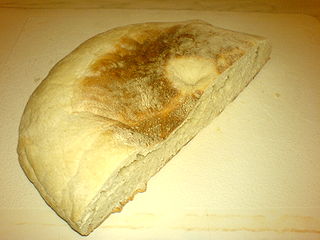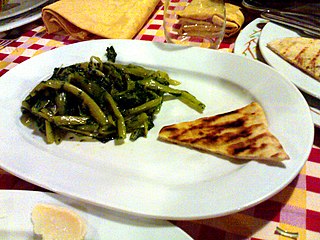
Pastry is baked food made with a dough of flour, water and shortening that may be savoury or sweetened. Sweetened pastries are often described as bakers' confectionery. The word "pastries" suggests many kinds of baked products made from ingredients such as flour, sugar, milk, butter, shortening, baking powder, and eggs. Small tarts and other sweet baked products are called pastries as a synecdoche. Common pastry dishes include pies, tarts, quiches, croissants, and pasties.

Chapati, also known as roti, rooti, rotli, rotta, safati, shabaati, phulka, chapo, poli, and roshi, is an unleavened flatbread originating from the Indian subcontinent and staple in India, Nepal, Bangladesh, Pakistan, Sri Lanka, East Africa, Arabian Peninsula and the Caribbean. Chapatis are made of whole-wheat flour known as atta, mixed into dough with water, oil (optional), salt (optional) in a mixing utensil called a parat, and are cooked on a tava.

A baguette is a long, thin type of bread of French origin that is commonly made from basic lean dough. It is distinguishable by its length and crisp crust.

Lefse is a traditional soft Norwegian flatbread. It is made with flour, can include riced potatoes, and includes butter, and milk, cream, or lard. It is cooked on a large, flat griddle. Special tools are used to prepare lefse, including a potato ricer, long wooden turning sticks and special rolling pins with deep grooves.

Filo or phyllo is a very thin unleavened dough used for making pastries such as baklava and börek in Middle Eastern and Balkan cuisines. Filo-based pastries are made by layering many sheets of filo brushed with oil or butter; the pastry is then baked.

A stottie cake or stotty is a type of bread that originated in North East England. It is a flat and round loaf, usually about 30 centimetres in diameter and 4 centimetres deep, with an indent in the middle produced by the baker. Elsewhere in the world, bread considered similar to the stottie is known as "oven bottom bread", though this term is a relative newcomer, given that, prior to the widespread use of cast iron ovens with shelves, ovens were built of brick and had only the bottom available to bake on. One chief characteristic is the heavy and dough-like texture of the bread. Though leavened, its taste and mouth-feel is heavy and very reminiscent of dough. It is heavy and dense because it has only been allowed to prove once rather than the usual twice. This indicates that its origins lie in the breads used to "test" ovens, and that it may be related to similar breads baked elsewhere in Europe for the same reason. Anecdotal evidence also suggests that some stotties were made with the offcuts of dough when all of the required loaves had been baked.

Gözleme is a savory Turkish stuffed turnover. The dough is usually unleavened, and made only with flour, salt and water, but gözleme can be made from yeast dough as well. It is similar to bazlama, but is lightly brushed with butter or oil, whereas bazlama is prepared without fat. The dough is rolled thin, then filled with various toppings, sealed, and cooked over a griddle. Gözleme may sometimes be made from prepackaged hand-rolled leaves of yufka dough.

Kue is an Indonesian bite-sized snack or dessert food. Kue is a fairly broad term in Indonesian to describe a wide variety of snacks including cakes, cookies, fritters, pies, scones, and patisserie. Kue are made from a variety of ingredients in various forms; some are steamed, fried or baked. Kue are popular snacks in Indonesia, which has the largest variety of kue. Because of the countries' historical colonial ties, Koeé (kue) is also popular in the Netherlands.

A rolling pin is a cylindrical food preparation utensil used to shape and flatten dough. Two styles of rolling pin are found: rollers and rods. Roller types consists of a thick cylinder with small handles at each end; rod type rolling pins are usually thin tapered batons. Rolling pins of different styles and materials offer varying advantages, as they are used for different tasks in cooking and baking.

Chicken and dumplings is a soup that consists of a chicken cooked in water, with the resulting chicken broth being used to cook the dumplings by boiling. A dumpling—in this context—is a biscuit dough, which is a mixture of flour, shortening, and liquid. The dumplings are either rolled out flat, dropped, or formed into a ball.

A kitchen scraper is a kitchen implement made of metal, plastics, wood, rubber or silicone rubber. In practice, one type of scraper is often interchanged with another or with a spatula for some of the various uses.

Chebureki are deep-fried turnovers with a filling of ground or minced meat and onions. They are made with a single round piece of dough folded over the filling in a crescent shape.

A great variety of cassava-based dishes are consumed in the regions where cassava is cultivated, and the ingredient is included many national or ethnic specialities.

A Schneeball or Schneeballen, snowball in English, is a deep-fried pastry made from shortcrust pastry especially popular in the area of Rothenburg ob der Tauber. Its name derives from its round, ball-like shape, its diameter of about eight to ten centimeters, and its traditional decoration with white confectioner's sugar. It is also known as a Storchennest.

A spit cake is a European-styled cake made with layers of dough or batter deposited, one at a time, onto a tapered cylindrical rotating spit. The dough is baked by an open fire or a special oven, rotisserie-style. Generally, spit cakes are associated with celebrations such as weddings and Christmas. The spit can be dipped in a thin dough, or the dough can be poured or rolled on the spit.

Crescia[ˈkreʃʃa] is a thin Italian flatbread typically prepared in Marche and Umbria. The crescia probably has a common ancestry to the piadina, to be found in the bread used by the Byzantine army, stationed for centuries in Romagna, in the north of the Marche (Pentapolis), and in the Umbrian Valley crossed by the Via Flaminia. The food is also known by the common name of "white pizza".
















